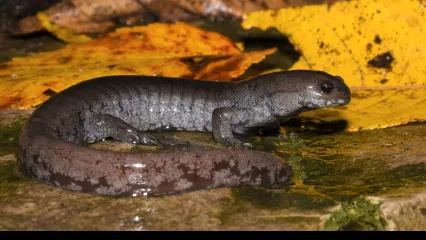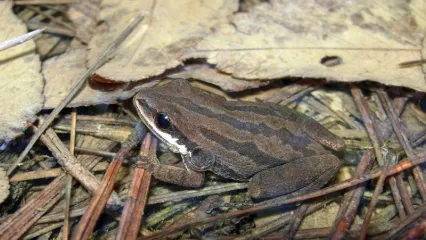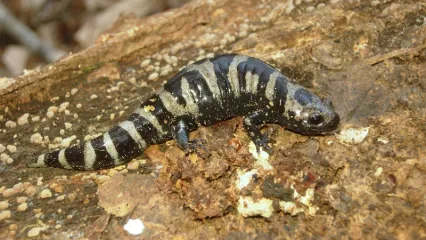
Description
Small-mouthed salamanders are moderate-sized salamanders with distinctively small heads and eyes. The entire body is dark, usually black, blue-black, or greenish-black with no conspicuous markings. Many individuals have a very subtle pattern of flecking that resembles the pattern of lichens. Front and hind legs are slightly lighter in coloration, often dark bluish or greenish. The tail is laterally compressed but there is no fin. The lack of distinguishing characteristics and overall uniform dark coloration help distinguish this salamander from others.
Size
This species can reach 7 inches in total length. Most adults vary from 4 to 6 inches in total length.
Habitat
Small-mouthed salamanders occupy a wide variety of habitats, from woodlands to pastures, and are often very common. Like other species of mole salamanders (in the genus Ambystoma), small-mouthed salamanders spend most of the year underground, except for when they breed. The distribution of small-mouthed salamanders in the United States extends from central Texas through Ohio, western Tennessee and western Alabama and north to south from southern Michigan to southeastern Texas.
Life Cycle
Adult small-mouthed salamanders migrate to temporary ponds during rainstorms in late winter or early spring (usually February or March). They breed in everything from low woodland ponds to roadside ditches. Migrations typically last only a few days. Once in the ponds, courtship occurs and males deposit a spermatophore (a stalk-like structure with a packet of sperm on the top) on the pond bottom and females pick up the spermatophore with their cloaca. Females can deposit from 300 to 800 eggs, but they usually deposit them in small clumps (50 eggs or less). The clumps are attached to vegetation in the water. The aquatic larvae transform during summer and leave the ponds.
Larvae feed on a variety of aquatic invertebrates. As the larvae increase in size, they include larger invertebrates in their diets. Adults feed on a variety of invertebrates and likely eat a lot of earthworms.
How To Observe
Because of their secretive habits, small-mouthed salamanders are difficult to observe, despite being relatively common where they occur. During spring mating migrations, they can often be found under logs or rocks near the ponds in which they breed. Larvae can be observed during spring and early summer by dip-netting ponds. However, in most parts of Oklahoma, small-mouthed salamanders co-occur with other species of mole salamanders, and it can be difficult to distinguish larvae of small-mouthed salamanders from larvae of other species of Ambystoma.
(This profile was created by Dr. Laurie Vitt as part of a partnership between the Wildlife Department and the Sam Noble Oklahoma Museum of Natural History. It was funded as part of a larger State Wildlife Grant to survey and inventory amphibians and reptiles of the Wildlife Management Areas of Oklahoma: T-35-P-1.)


